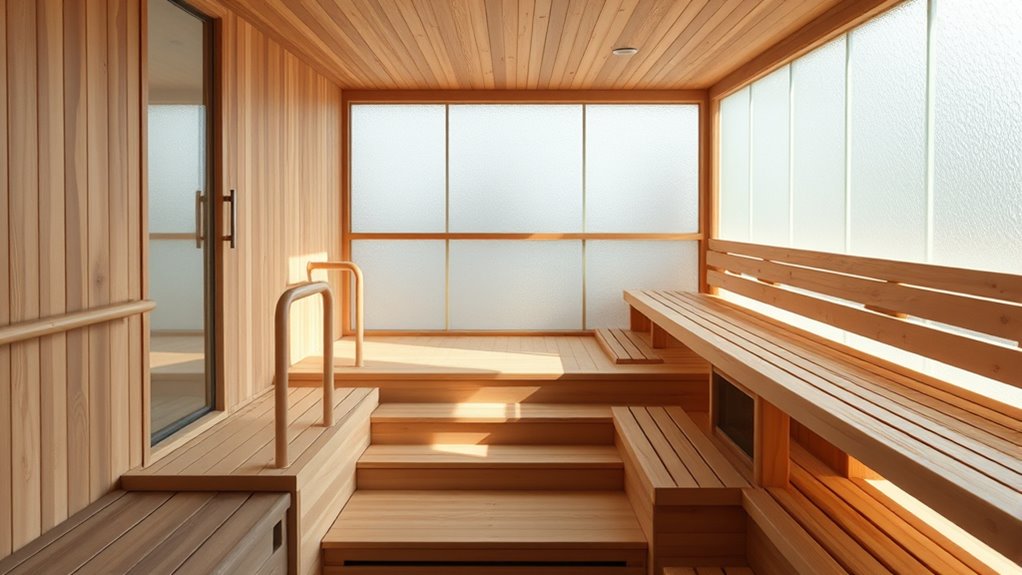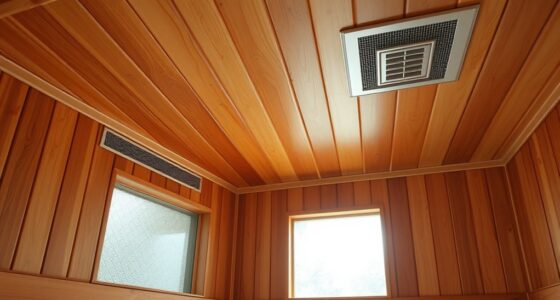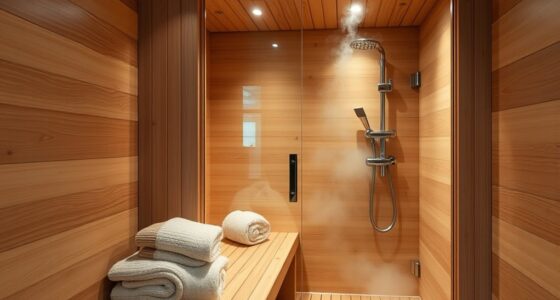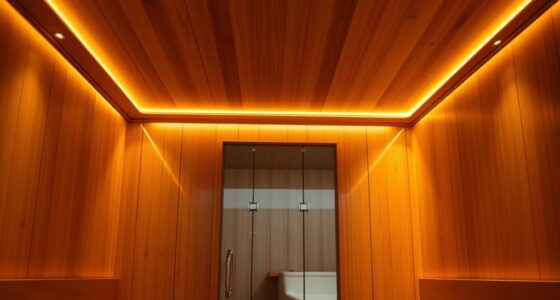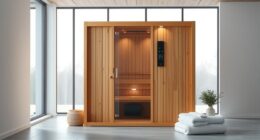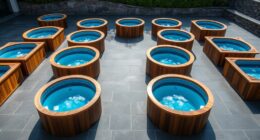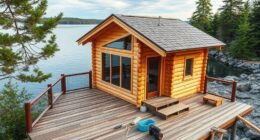To make a sauna accessible for people with mobility challenges, guarantee the entrance is wide enough and the door handles are easy to operate. Install non-slip flooring, supportive handrails, and seating options at different heights for comfort. Control panels should be within easy reach, and safety features like emergency buttons and clear signage are essential. Thoughtfully designed elements create a welcoming, safe environment—exploring these features further will help you develop an inclusive sauna space.
Key Takeaways
- Ensure doorway widths are at least 36 inches with easy-to-operate handles for wheelchair access.
- Install smooth, level, non-slip flooring and secure surfaces to prevent slips and facilitate mobility.
- Incorporate adjustable seating, accessible control panels, and supportive handrails at appropriate heights.
- Use bright, even lighting, clear signage, and accessible emergency controls to enhance safety and visibility.
- Design clear pathways, marked exits, and ventilation systems to promote safety, comfort, and ease of movement.
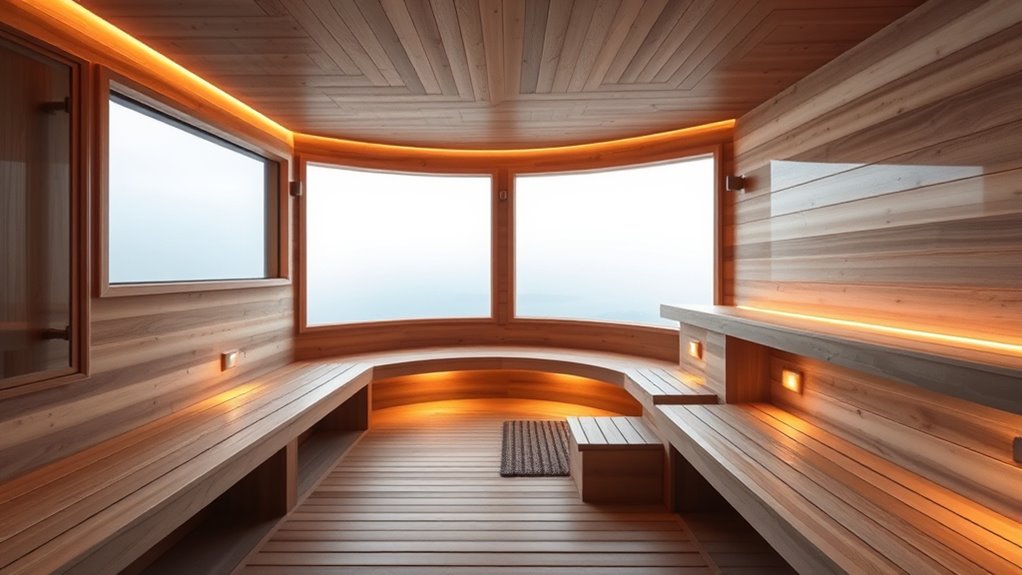
Creating a sauna that accommodates people with mobility challenges is essential for promoting inclusivity and ensuring everyone can enjoy its health benefits. When designing such a space, prioritizing wheelchair accessibility is crucial. You want to make sure the sauna entrance is wide enough to comfortably accommodate wheelchairs, typically at least 36 inches, and that door handles are easy to operate without requiring tight grasping or twisting. Smooth, level pathways inside the sauna eliminate tripping hazards and make navigation easier for users with mobility devices. Non-slip flooring is vital to prevent slips and falls, especially in a humid environment like a sauna. You might consider textured tiles or rubber mats, but always ensure they’re securely installed and dry quickly to maintain safety. Additionally, incorporating accessible design features ensures the space is practical and welcoming for all users.
Safety considerations extend beyond just the physical layout. Heat levels and humidity should be carefully monitored to create a comfortable environment for everyone, including those with mobility challenges who might have difficulty adjusting to rapid temperature changes. Installing accessible control panels at a lower height ensures users can easily adjust temperature and humidity settings without needing assistance. Handrails positioned at strategic points, such as near benches and entryways, provide stability and support, helping prevent falls when entering, exiting, or moving around inside. Seating options should include both benches at different heights and accessible seats designed for those who may need additional support, ensuring comfort and safety for every visitor.
Ensure safety with accessible controls, supportive handrails, and versatile seating options for all users.
Lighting plays a significant role in safety and accessibility. Bright, even lighting reduces shadows and helps users see clearly, minimizing accidents. Consider adding illuminated signage with simple instructions for operating features or emergency procedures. Ventilation is another safety aspect; good airflow not only maintains comfort but also reduces the risk of overheating or dehydration. Properly placed vents and fans ensure consistent air circulation, making the sauna safer for users with varying health needs.
Finally, you should think about emergency preparedness. Clearly marked exits, easily reachable emergency buttons, and accessible communication systems ensure that help is readily available if needed. Providing staff training on assisting individuals with mobility challenges can also improve safety and comfort. By thoughtfully integrating wheelchair accessibility features and safety considerations into your sauna design, you create an inclusive space where everyone can relax, rejuvenate, and enjoy the health benefits without concern for barriers or risks. Your focus on accessibility demonstrates a commitment to inclusivity that benefits the entire community and enhances the overall experience for all users.
Frequently Asked Questions
What Is the Average Cost to Modify a Sauna for Accessibility?
The average cost to modify a sauna for accessibility ranges from $2,000 to $8,000, depending on the extent of the changes. Cost considerations include installing ramps, grab bars, widened doorways, and non-slip flooring. You should account for modification expenses like labor, materials, and any custom features needed. Planning ahead helps you stay within budget while ensuring safety and comfort for mobility challenges.
Are There Specific Building Codes for Accessible Saunas?
Imagine stepping into a sauna where smooth, wide doorways lead you effortlessly inside. Building codes for accessible saunas prioritize safety and inclusivity, requiring compliance with accessibility standards. You must guarantee features like grab bars and non-slip surfaces meet specific building code guidelines, which vary by location. Check local regulations before designing, so your sauna provides a comfortable, safe experience while fully adhering to the necessary accessibility standards.
How Long Does It Take to Retrofit an Existing Sauna?
Retrofitting an existing sauna typically takes anywhere from a few weeks to a couple of months, depending on the scope of renovation planning and the complexity of accessibility features you want to add. The retrofitting timeline varies based on structural adjustments, electrical work, and ensuring compliance with building codes. You should plan carefully, coordinate with contractors early, and allocate extra time for inspections to smoothly complete the project.
Can Portable or Temporary Solutions Improve Accessibility?
Yes, temporary solutions and portable modifications can considerably improve accessibility in your sauna. You can add portable grab bars, foldable seats, or ramps that are easy to install and remove when needed. These temporary solutions allow you to customize accessibility without extensive renovations. They’re ideal for testing what works best or accommodating visitors with mobility challenges, ensuring everyone can enjoy the sauna comfortably and safely.
What Are the Maintenance Requirements for Accessible Sauna Features?
You should regularly follow cleaning protocols to keep accessible sauna features hygienic and safe. This includes wiping down surfaces, disinfecting handles, and ensuring non-slip mats stay clean. You also need to perform safety inspections, checking that ramps, grab bars, and seating are secure and in good condition. Consistent maintenance prevents accidents, prolongs equipment life, and guarantees everyone can enjoy a safe, accessible sauna experience.
Conclusion
Making your sauna accessible transforms it into a welcoming space for everyone. By incorporating features like wider doors and sturdy seating, you guarantee safety and comfort for those with mobility challenges. Did you know that over 13% of adults in the U.S. have some form of mobility impairment? By making these simple changes, you create an inclusive environment that everyone can enjoy. Your efforts promote health, relaxation, and community for all users.
